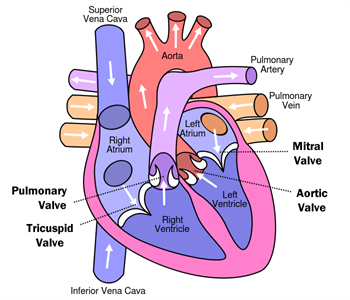Shared Content Block:
Surgery Styles -- "surgery-flex-gallery" class
Heart Valve Repair/Replacement

The heart is a continuously beating pump that keeps the body supplied with oxygenated blood. The left side of the heart receives oxygenated blood from the lungs and pumps this oxygenated blood out to the body. The right side of the heart receives de-oxygenated blood from the body and pumps it to the lungs where it will be re-oxygenated.
Inside the heart are four valves (Pulmonary, Tricuspid, Aortic, and Mitral). When healthy and working properly, these valves keep the blood flowing in the right direction.
Heart valves can lose function due to a variety of causes. Heart valves may not open completely (a condition referred to as stenosis) or they may not close completely (referred to as regurgitation). Heart Valve Disease is associated with a variety of symptoms, and surgical intervention is often the preferred course of treatment.
Heart Valve Repair
The mitral valve is the most commonly repaired heart valve, but all four of the valves may be repaired (rather than replaced) depending upon the nature and severity of heart-valve disease present.
The most common heart-valve repair techniques are commissurotomy, in which fused valve leaflets (flaps) are separated to widen the opening; decalcification, in which calcium deposits are surgically removed to allow the valve to function properly; and leaflet reshaping, in which poorly functioning sections of a valve leaflet are removed.
Heart Valve Replacement
Depending upon the nature and severity of heart valve disease, your physician may recommend valve replacement surgery as the most appropriate form of treatment. Disease of the aortic valve and the pulmonic valve are more often treated with valve replacement rather than repair. Valve replacement can involve the use of either mechanical, biological, or allograft valves.
TAVR
Transcatheter Aortic Valve Replacement (TAVR) is a commonly performed, minimally invasive heart-valve replacement surgery. In TAVR, a new aortic valve is delivered to the site of implantation by way of a catheter. The catheter is typically inserted into the body at the femoral artery in the groin area and guided along this artery to the heart. As an alternative to open heart surgery, this type of heart-valve surgery usually results in a shorter recovery time. It can be particularly beneficial for patients who are too ill to undergo open heart valve-replacement surgery.
Appointments and Information
This information is provided by the Department of Surgery at the University of Colorado School of Medicine. It is not intended to replace the medical advice of your doctor or healthcare provider. Please consult your healthcare provider for advice about a specific medical condition.